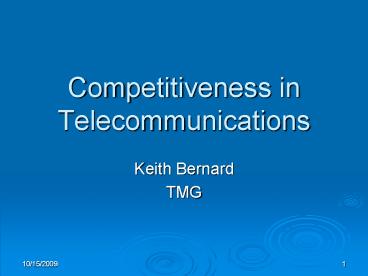Competitiveness in Telecommunications - PowerPoint PPT Presentation
1 / 12
Title:
Competitiveness in Telecommunications
Description:
Long distance oligopoly. VoIP (internet telephony) competitive ... Oligopoly. Joint ownership with landline horizontal integration. Issues: Universal Service ... – PowerPoint PPT presentation
Number of Views:63
Avg rating:3.0/5.0
Title: Competitiveness in Telecommunications
1
Competitiveness in Telecommunications
- Keith Bernard
- TMG
2
Forces Involved
- Technological Change
- Convergence
- Technological platforms digital transmission
- Cluster market economies of scope
- Services voice, data video all provided via
different networks - Markets no longer coincide with industry
- Network economics
- Consumption externalities
- Very large proportion of fixed and sunk costs
- Regulation
- Open entry elimination of license restrictions
- Enhance demand substitutability e.g. number
portability - BUT some legacy carryover
- Required use of infrastructure for some operators
at regulated prices - Exemption from charges for some services
- Spectrum use highly regulated
3
Inter-relation
- Technological change
- Changes economics of entry
- Bundling of services over a common network
- Requires adaptation of regulatory model
- Pricing of essential facilities
- Equivalent treatment of substitute services
- Permitted use of radio spectrum
- BUT, in turn, regulation affects
entry/competitive conditions
4
History
- FCC licensing segmented markets by type of
service and technology employed e.g. voice, data
(enhanced services), video, etc - Facilitated by specialized technology
- Result largely oligopolistic market structure
and high degree of regulation, even market
management.
5
History continued
- Technology began to break down licensing
distinctions so that role of FCC was to
restrict/limit entry into previously protected
markets. - Criterion was abuse of dominance
- Well beyond margin squeeze/predatory pricing
- Rules for terms of availability for access to
essential facilities and even social compact - Access to local loop
- Expenditure for universal service
6
Last continuation
- At the same time, new competitors wanted to
retain various exemptions from prior regulatory
regime - Exemption from access charges for enhanced
service providers - Ensured resale profit margins for resellers
- Reciprocity in provision of international services
7
Current market structure
- Narrowband services voice, dial-up data
- Landline
- Local monopoly/duopoly
- Long distance oligopoly
- VoIP (internet telephony) competitive
resellers - Mobile 2G
- Oligopoly
- Joint ownership with landline horizontal
integration - Issues Universal Service
- VoIP access charge exemption
- Sunk Costs
- Product bundles
- New technology handsets will eliminate
landline/mobile distinction
8
Current Market Structure
- Broadband services
- Landline (quasi- broadband)
- Duopoly (ADSL cable modem)
- Mobile ?
- Mobile 3G
- Monopoly/oligopoly
- Joint ownership migration strategy technology
dependent - Wireless
- Unlicensed WiFi (intra-building) WiMax (loops
future mobile) - Issues Competition
- New Investment
- Spectrum Policy
9
FCC Policy
- Narrowband
- Open entry
- Limited price regulation
- But failure on essential facilities
- TELRIC, especially UNE-P
- Access charge exemption for VoIP
- Adequate spectrum
- Supply substitutability
- Enhanced demand substitutability
- Mobile/mobile fixed/mobile portability
- Issues Prices beginning to increase
- Universal service charges
10
FCC Policy
- Broadband
- Carry-over from narrowband essential facilities
- Low level of landline upgrade of PSTN
- Concern for spectrum interference from unlicensed
operators - Unlicensed operators pay no spectrum fees
- Inflexible spectrum use and inadequate allocation
- FCC spectrum demand is going forever to
outstrip supply
11
Indicators
- Europe
- Ratio of ADSL to cable is 21 reverse ratio
from US - Europe didnt employ TELRIC
- Asia
- Greater technological advance than US
- Maximum consumer data rate more than 3X that in
US - Lower prices per unit of throughput
- From 50 to 15 of US price
12
The way forward
- FCC immediately terminate TELRIC rules
- FCC apply (revised) Universal Service Charges to
all equivalent services - FCC eliminate service rules for spectrum use and
permit unrestricted secondary markets for all
spectrum commercial and military



























![Telecommunications Equipment Industry Forecasts - China Focus[ 2015] PowerPoint PPT Presentation](https://s3.amazonaws.com/images.powershow.com/8214826.th0.jpg?_=20151013065)



